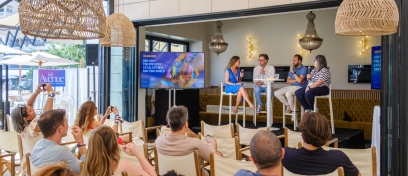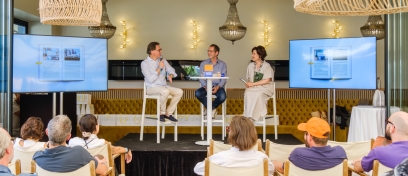Dreaming bigger: how OOH can lead change for female representation in advertising
2019 marked the latest edition of the FIFA Women’s World Cup, and brought a 21st century equivalent of ‘We Can Do it!’, the inspirational poster produced in the US during the Second World War and commonly known as Rosie the Riveter. This time, we didn’t get a government message motivating women to work but instead a commercial brand promoting itself as the voice of female empowerment and gender equality in sports.
Using its reputation as the most trusted brand among millennials and the 21st most valuable* brand globally, Nike delivered the message that anyone, and especially women, can achieve their dreams with the power of hard work, no matter who they are.
The campaign, entitled ‘Dream With Us’, began with a television commercial, followed by large billboards and murals across American cities, with bold, simple messaging implying that women shouldn’t be asking whether their dreams are crazy - but if they are crazy enough.
‘Dream With Us’ garnered a positive response, amplified by welcoming reactions from celebrities on social media. Led by influential athletes such as tennis player Serena Williams and footballer Megan Rapinoe, the campaign was widely viewed as exposing empty gender stereotypes and celebrating female achievement in sport.
To which the reaction of many might be - so what? Surely we know by now that gender stereotypes are harmful, and we’d do well to dismantle them? Apparently not: even a quick internet search reveals the unsavoury truth that sexism in brand communications and advertising is alive and well. The mixed reaction to the ‘arrogance’ of the US World Cup-winning team is instructive, reminding us of how quick some people are to police successful women’s emotions and behaviour.
Why brands?
OK, so why do we need a company like Nike to inform us about gender issues? Because we trust brands more than other sources. In an age when trust in governments is shrinking, consumers are increasingly looking to brands for moral leadership. 2019 research from marketing consultancy Edelman shows that people trust business more than the government. And according to the 2017 Cone Communications CSR Study, 55% of consumers believe that companies have a greater role than governments in creating a better future, while 86% of people in the US expect companies to act on social issues.
How can OOH help?
This means that brands like Nike now have unprecedented influence, which they translate to peoples’ everyday lives via advertising media platforms. Out-of-home (OOH) has particular impact, as it occupies the ‘active space’ – away from home, people are more alert and receptive to non-invasive brand messaging that complements their environmental surroundings – and so holds the key to subconscious consumer attitudes.
Recognising the importance of the social effects of advertising on gender perception, the UK’s Advertising Standards Authority (ASA) recently enforced stricter regulations on advertising content that promotes stereotypical gender roles, sexism and sexualisation. These regulations have not only reduced negative content around these issues but have incentivised brands to take moral leadership on such social movements.
Perhaps these and similar initiatives, such as London’s ‘The Women We See’ scheme, are helping to make a change. A study by the UCL Institute of Education on women and teenage girls found that 49% feel the quality of outdoor advertising has improved over the last few years, where OOH was found to be comparatively representative when measured against television or targeted social media (21%). The insights also indicated that messages of female empowerment were increasingly present in OOH advertising, where respondents were more likely to note them as interesting and relevant.
OOH benefits from the range of senses it can reach. Skincare brand Olay worked with JCDecaux to launch an audio-visual campaign in the Shanghai metro to encourage women to pursue their dreams. In the People’s Square station, passengers encountered Olay’s ‘star wall’, decorated with 15 shining stars, representing 15 women. When passengers touched a star, a sound device was activated, telling each woman’s story and dreams.
More challenges ahead
There’s undoubtedly more work to do on this issue, and brands face further hurdles, such as differing cultural expectations around the world regarding female empowerment – what works in the US might not necessarily work in other countries, for example.
Take weight loss brand Protein World’s ‘Beach Body Ready’ campaign depicting a slender female figure sporting a bright yellow bikini. Because of the suggestion that women that look different are not ready for the beach, the ad stirred controversy in the UK and was banned. Protein World ran the same campaign in New York, installing a mammoth poster towering above pedestrians like a skyscraper. While the poster discouraged the confidence of some female onlookers, others looked on it more light-heartedly.

Brands are using their influence to shape urban spaces around the world to be more inclusive. For example, using street signs in the outdoor space, Nike created a clever campaign to highlight this habituation of gender equality. In Bogota, Colombia, the brand invited women to alter street signs from ‘male’ to ‘female’ figures, using ponytail magnets that they could attach to metal signage while taking exercise. The initiative increased the number of female figures across the city, creating awareness of how figures of women are rarely used other than to indicate women’s bathrooms. By changing these signs, the campaign aimed to change public opinion and empower women, with a special focus on perceptions around sports signage in order to raise the issue of gender equality in sports.
Despite the progress of representation of women in advertising being more pronounced in some markets compared to others, it seems that we’ve reached a watershed moment: with influential brands and local authorities working together to take action, there’s reason for optimism. And what better medium to lead this change – democratic, accessible, embedded in the urban environment – than OOH?
Want to know more?



